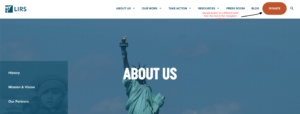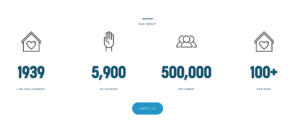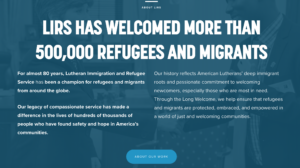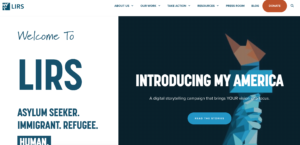The Lutheran Immigration and Refugee Service is a non-profit organization that specializes in helping incoming refugees get asylum within the United States. In this essay, I will be giving a rhetorical analysis of Lirs.org, which is the home website for the Lutheran Immigration and Refugee Service. In this rhetorical analysis I will be analyzing the website’s author, audience, purpose, context, and genre. I will give support to this analysis with my own words and visual captures from the website to help give a better understanding.
The author of this website is technically not defined, but we can say that the website is a representative of the Lutheran Immigration and Refugee Service (LIRS). I inferred that the author of this website may be the board of directors for LIRS. The board of directors for LIRS consists of 17 members who are experienced with immigration and refugees. These 17 members are also located throughout the United States.
Who is the intended audience? The primary intended audience for the Lutheran Immigration and Refugee Service is potential donors and/or volunteers. I know this because on the main navigation bar of the website, the only navigation option that is a different color is the donate button. This tells me that they want this specific button to pop out and grab the users attention.

As you can see with the provided screenshot above, all of the other navigation options are the same color/size. But the “donate” option is not only a different color, but also bigger than the rest. This shows that they are trying to grab the attention of potential donors.
The second intended audience for LIRS are the potential refugees that are seeking asylum within the United States. I know this because of the “resources” section on the LIRS website. This section contains a ton of information about how someone could seek LIRS services if they are in need. How do I know this is secondary audience and not a primary? Well, the resources sections is the same color as the rest of the navigation options. Unlike the “donate” button which is designed to stand out to the user.
The purpose of the Lutheran Immigration and Refugee Service website LIRS is to be able to efficiently collect donations and volunteer support. I find this conclusion because as stated above, in the navigation bar the main section that clearly stands out is the “donate” button. This is them clearly wanting to drive the users attention to the donate button. Another reason why I came to this conclusion is that the entire main homepage is that of a sales pitch. Everything they’re talking about on the home page is essentially giving the user a reason to donate.


The following images above are the examples of them trying to sell themselves to donators. These two information graphics are on the landing page of LIRS’ site. These info graphics clearly are stating their accomplishments and their upside. Each graphic then links to their “about us” section which describes better in detail these accomplishments and what exactly they do at LIRS. In my opinion, these feel like a sales tactic in order for them to gather donations and support.
The medium for the LIRS is the web. I believe the organization chose the web because it offers the largest reach over all the other potential mediums. The web is also completely free and is accessible to anyone who can access a device that can access the internet. You do not have to pay anything to be able to access this site and it’s information. Unlike other mediums like print, newspapers, CDs, etc. where you actually have to buy the service just to get exposed to the information it contains. The site follows a relatively strict color code of blue and white. This gives the sense that it was professionally built, which is also a means of recruiting donations and support. A donator isn’t going to donate to an organization with what seems like a poorly made and designed website. There are a ton of images on this site. Most of them are images of the people that help or have helped in the past, other photos are of immigrants or refugees or are in need of help. This is a play on emotions. It makes the user emotional which then would help them donate or support the cause.
The genre for this website is a non-profit charitable organization. This is a non-profit because it does not use its earnings as profit. I would classify this as a charitable organization because it accepts donations in cash form and uses those donations to help the immigrants and refugees. This website is very similar to other non-profit organizations’ websites because they all follow the same format. They have a professional theme and color scheme. Followed by an image with their navigation bar on top of that image. They also all share the same mentality of making the “donate” buttons or section stand out. The images they use capture emotion and makes the user feel like they need to help so they can make a difference.
I genuinely believe that this website is great. It properly appeals to its primary and secondary audiences respectively, its purpose to clear and simple, and it utilizes the web to the best of its capabilities. I do believe that there are a few changes that I would make to the site to better improve it. One would be to add more images and even a video.

I think they should replace these images on the landing page with a short video that loops and has no sound. This video should consist of some of the organizations day-to-day operations, their accomplishments, and compelling images that appeals to the readers emotion. I think that would greatly improve the ability for the homepage to grab the readers attention. Another change I would make that would improve this site is to offer more “resources”. Although these resources within the “resources” section are good, some of them are vague and do little for the reader. I think if they added some more content that is actually useful to the user, it would greatly improve this section of the site.
Citation:
“Lutheran Immigration and Refugee Service.” LIRS, 6 Feb. 2019, www.lirs.org/.